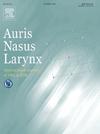Characterization of microbial diversity and eosinophilic otitis media biomarkers using next-generation sequencing
IF 1.6
4区 医学
Q2 OTORHINOLARYNGOLOGY
引用次数: 0
Abstract
Objective
Eosinophilic otitis media (EOM) is a chronic eosinophilic inflammatory disease linked to bronchial asthma and nasal polyps. EOM is often accompanied by tympanic membrane perforation. Although the primary treatment, steroid therapy, is generally effective, its efficacy may be limited in advanced cases, particularly those involving significant thickening of the middle ear mucosa. Despite its clinical importance, details regarding the pathogenesis of EOM have not been elucidated. Our study aimed to characterize the microbiome associated with EOM and explore changes with and without tympanic membrane perforation.
Methods
We enrolled 27 patients clinically diagnosed with EOM, 25 controls without middle ear infections, and 10 patients with chronic suppurative otitis media (CSOM) [1] [2]. Specimens were collected by swabbing the middle ear, nasopharynx, and external auditory canal (EAC) of subjects in the EOM and control groups, whereas CSOM specimens were collected only from the middle ear. The V3-V4 regions of the 16S ribosomal RNA genes were amplified and subjected to high-throughput sequencing. We evaluated alpha and beta diversity indices between the EOM and control subjects, followed by Linear discriminant analysis Effect Size (LEfSe) analysis to identify potential biomarkers. Additionally, co-occurrence patterns were analyzed to explore the associated microbial interactions. To assess whether similar biomarkers were identified between the EOM and CSOM subjects, LEfSe analysis was conducted for these two groups.
Results
Compared with controls, EOM patients were significantly enriched in Nocardioides in the middle ear, nasopharynx, and EAC, highlighting a distinct microbiological feature. Both alpha and beta diversity were significantly reduced in EOM patients with tympanic membrane perforation. When comparing the EOM and CSOM groups, Nocardioides was consistently identified as a significant biomarker for EOM, confirming its distinct association with EOM. In co-occurrence analysis, Nocardioides showed notable positive co-occurrence with several other genera.
Conclusion
This study reports the first detailed exploration of the EOM microbiome and identified Nocardioides as a new biomarker. The significant shift in microbial co-occurrence associated with tympanic membrane perforation may contribute to the disease's refractory nature, suggesting new avenues for understanding and managing EOM.
利用新一代测序技术确定微生物多样性和嗜酸性中耳炎生物标志物的特征。
目的:嗜酸性中耳炎(EOM)是一种慢性嗜酸性炎症性疾病,与支气管哮喘和鼻息肉有关。EOM 常伴有鼓膜穿孔。虽然类固醇治疗这一主要治疗方法通常有效,但对于晚期病例,尤其是中耳粘膜明显增厚的病例,其疗效可能有限。尽管EOM具有重要的临床意义,但有关其发病机制的细节尚未阐明。我们的研究旨在描述与EOM相关的微生物组的特征,并探讨鼓膜穿孔时和未穿孔时的微生物组变化:我们招募了 27 名临床诊断为 EOM 的患者、25 名未患中耳炎的对照组患者和 10 名慢性化脓性中耳炎(CSOM)患者 [1] [2]。EOM组和对照组的标本通过拭取中耳、鼻咽部和外耳道(EAC)来采集,而CSOM组的标本仅从中耳采集。我们扩增了16S核糖体RNA基因的V3-V4区域,并对其进行了高通量测序。我们评估了EOM和对照组之间的α和β多样性指数,然后进行了线性判别分析效应大小(LEfSe)分析,以确定潜在的生物标记物。此外,我们还对共生模式进行了分析,以探索相关的微生物相互作用。为了评估EOM和CSOM受试者之间是否发现了相似的生物标志物,对这两组受试者进行了LEfSe分析:结果:与对照组相比,EOM患者的中耳、鼻咽部和EAC中的Nocardioides明显增多,突出了一个独特的微生物特征。在鼓膜穿孔的EOM患者中,α和β多样性均明显减少。在对EOM组和CSOM组进行比较时,Nocardioides一直被认为是EOM的重要生物标志物,这证实了它与EOM的独特联系。在共生分析中,Nocardioides与其他几个属的共生率呈显著的正相关:本研究首次详细探讨了EOM微生物组,并确定Nocardioides为一种新的生物标记物。与鼓膜穿孔相关的微生物共存情况发生了重大变化,这可能是该病难治的原因之一,为了解和治疗EOM提供了新的途径。
本文章由计算机程序翻译,如有差异,请以英文原文为准。
求助全文
约1分钟内获得全文
求助全文
来源期刊

Auris Nasus Larynx
医学-耳鼻喉科学
CiteScore
3.40
自引率
5.90%
发文量
169
审稿时长
30 days
期刊介绍:
The international journal Auris Nasus Larynx provides the opportunity for rapid, carefully reviewed publications concerning the fundamental and clinical aspects of otorhinolaryngology and related fields. This includes otology, neurotology, bronchoesophagology, laryngology, rhinology, allergology, head and neck medicine and oncologic surgery, maxillofacial and plastic surgery, audiology, speech science.
Original papers, short communications and original case reports can be submitted. Reviews on recent developments are invited regularly and Letters to the Editor commenting on papers or any aspect of Auris Nasus Larynx are welcomed.
Founded in 1973 and previously published by the Society for Promotion of International Otorhinolaryngology, the journal is now the official English-language journal of the Oto-Rhino-Laryngological Society of Japan, Inc. The aim of its new international Editorial Board is to make Auris Nasus Larynx an international forum for high quality research and clinical sciences.
 求助内容:
求助内容: 应助结果提醒方式:
应助结果提醒方式:


